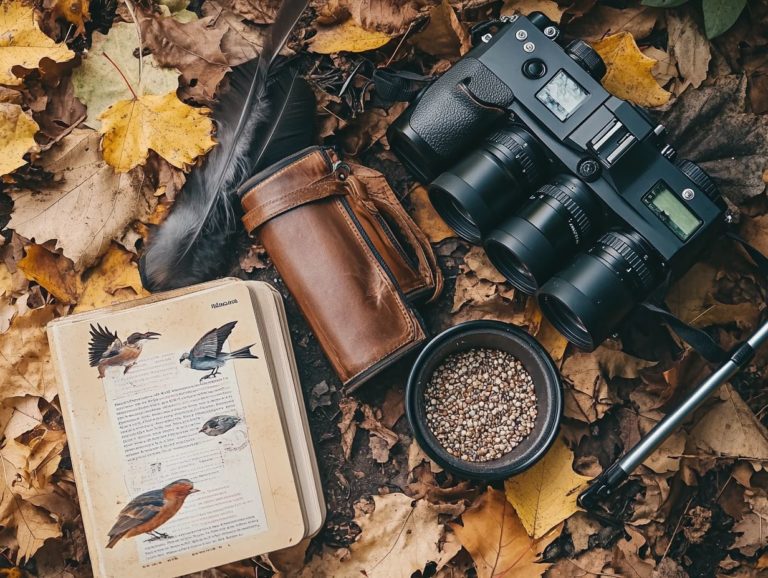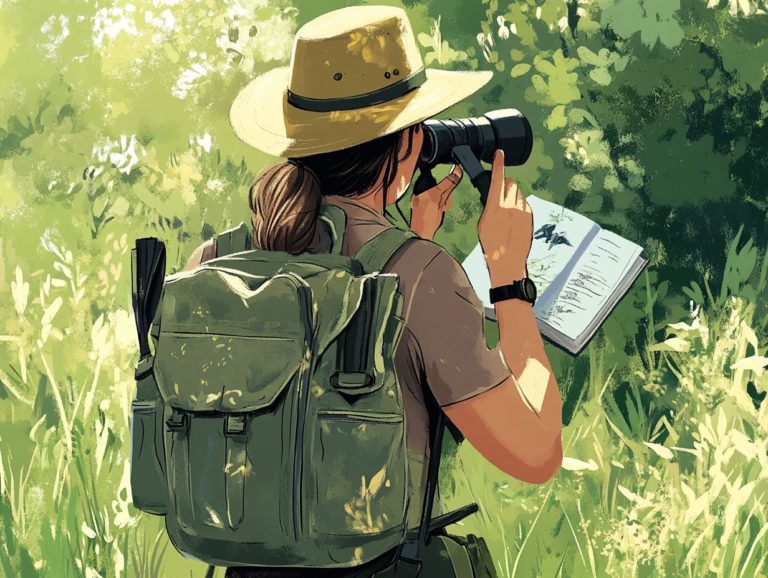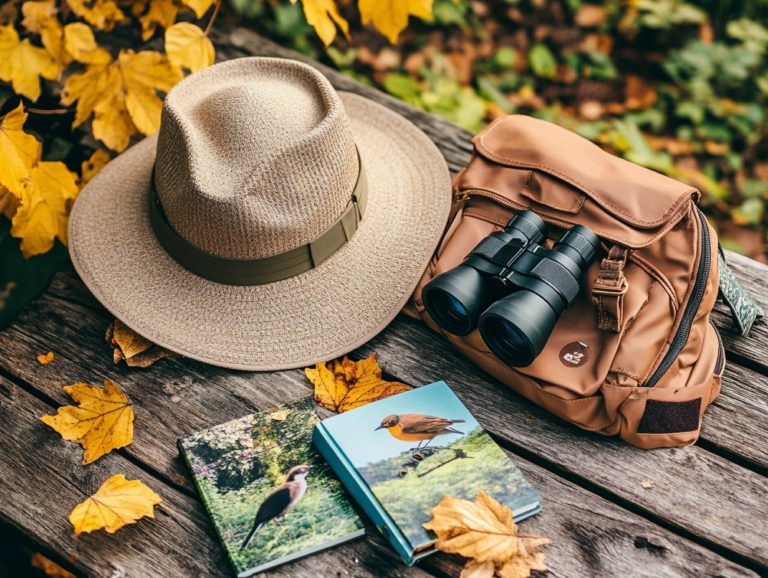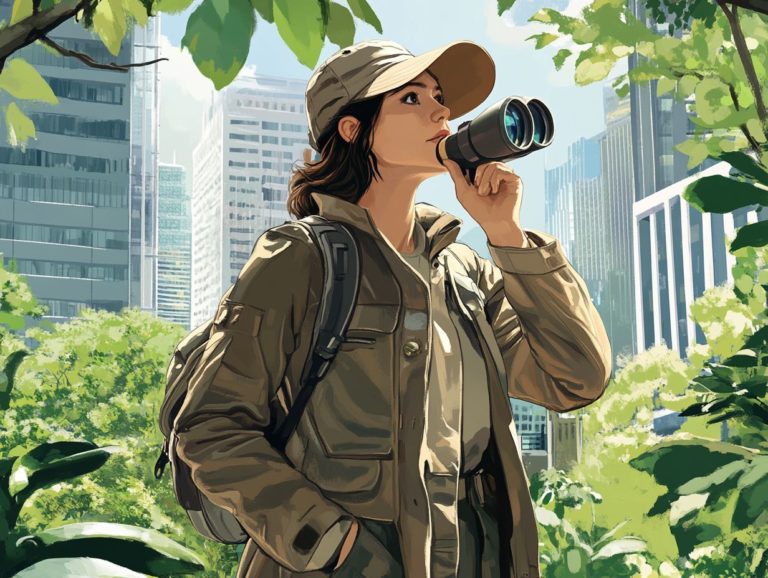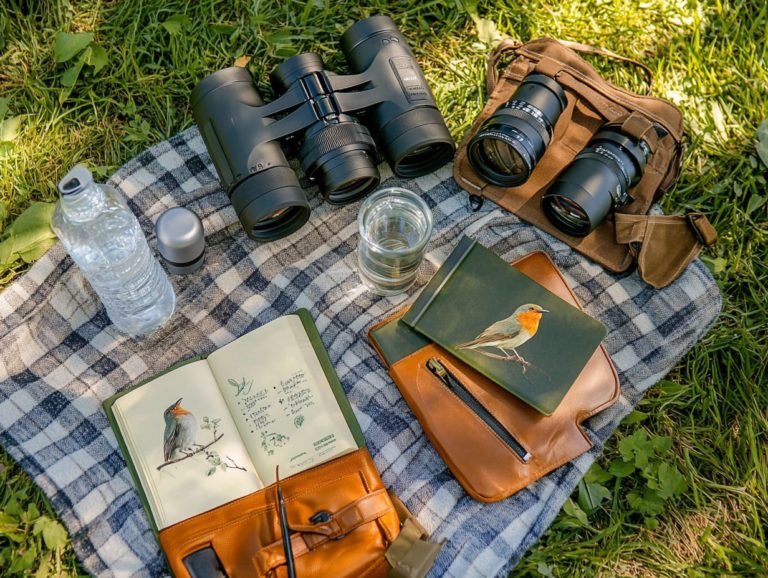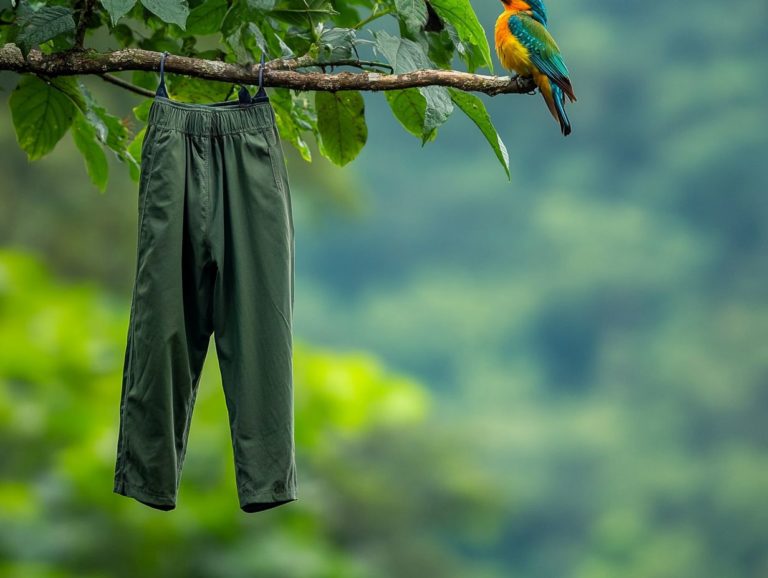Best Accessories for Bird Watching in National Parks
Bird watching is a truly fulfilling outdoor pursuit, offering you the chance to connect with wildlife amidst breathtaking natural landscapes.
This article delves into some of North America’s finest national wildlife refuges and parks, such as Bosque del Apache and Point Pelee, where you can fully immerse yourself in a variety of ecosystems teeming with avian life.
We ll discuss the essential gear that will elevate your birding experience, ensuring you’re thoroughly prepared for your next adventure.
Embark with us as we explore these avian hotspots!
Contents
- Key Takeaways:
- Bosque del Apache National Wildlife Refuge Visitor Center
- Great Dismal Swamp National Wildlife Refuge
- Henderson Bird Viewing Preserve
- Bombay Hook National Wildlife Refuge
- Birding Bob
- Madera Canyon
- Everglades Safari Park
- Rouge National Urban Park, Woodland Day Use Area
- Point Pelee National Park
- Mississippi National River & Recreation Area
- Indiana Dunes National Park
- What to Bring for Bird Watching in National Parks
- Birding Checklist
- Birding Apps
- Frequently Asked Questions
- What are the best accessories for bird watching in national parks?
- Which national parks are the best for bird watching?
- What is the importance of a field guide for bird watching in national parks?
- Why is it important to have a birding journal while bird watching in national parks?
- What type of camera is best for bird watching in national parks?
- Are there any national parks outside of the US that are good for bird watching?
Key Takeaways:
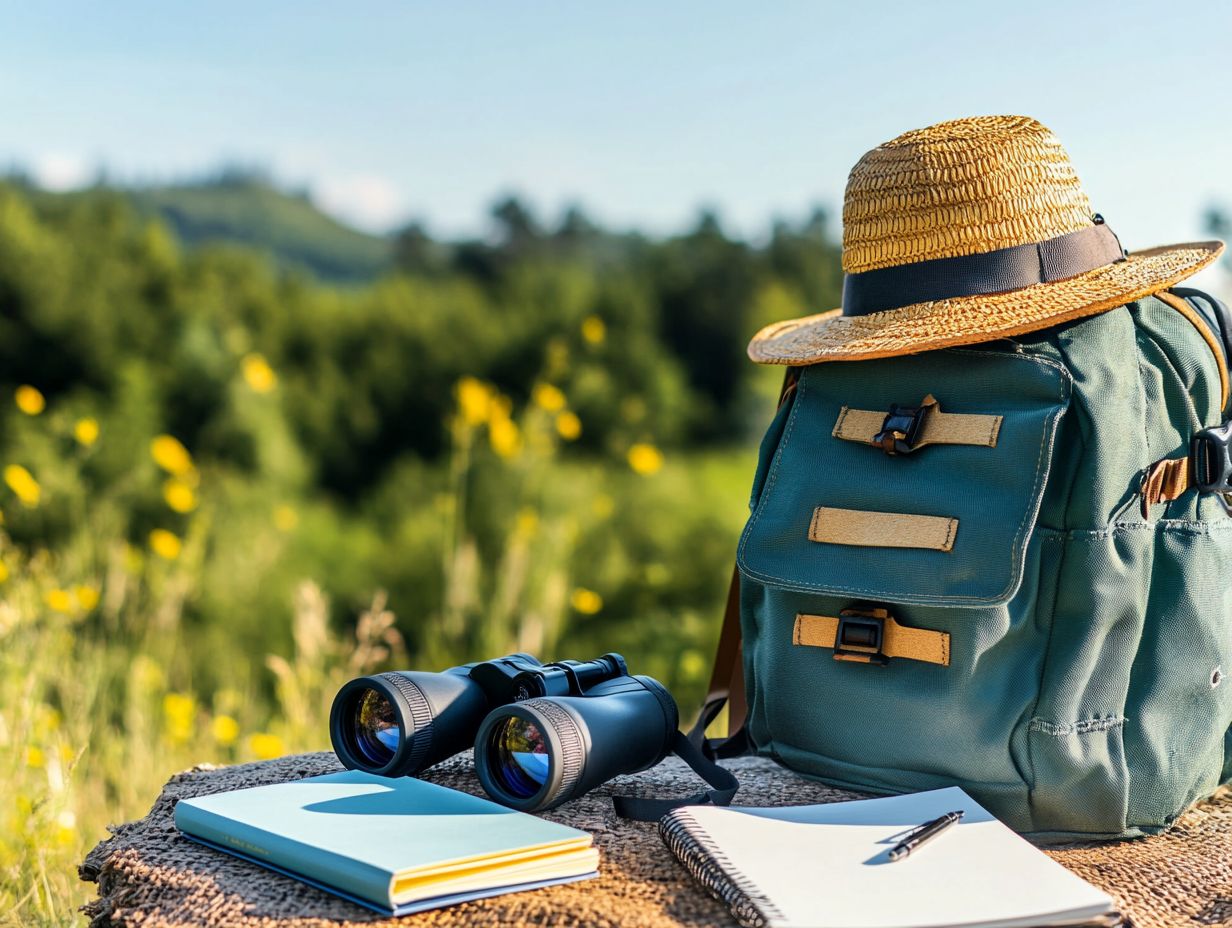
- Don’t forget your binoculars – they are essential for spotting and identifying birds in national parks.
- Bring a field guide to help you identify different bird species and learn more about their behaviors and habitats.
- Capture the beauty of bird watching with a camera and telephoto lens, which is a camera lens that allows you to take close-up shots from a distance.
Bosque del Apache National Wildlife Refuge Visitor Center
Nestled in the heart of New Mexico, the Bosque del Apache National Wildlife Refuge Visitor Center is an extraordinary place for bird watching and photography. Here, you ll love discovering a stunning variety of species, including migratory birds and coastal seabirds.
The refuge is a mosaic of wetlands, fields, and riparian zones that create unique habitats, attracting an impressive array of wildlife. Fall and spring are prime times for bird watching when the skies are alive with the vibrant spectacle of thousands of cranes and geese.
To enhance your viewing experience, investing in high-quality binoculars, such as the Nikon Prostaff or Vortex Diamondback, is highly recommended. Additionally, considering the top accessories for bird watching with kids can help you capture the intricate details of the feathered visitors that grace the skies.
The area also provides fantastic photography opportunities, making it an ideal destination for both budding and seasoned photographers.
For those looking to elevate their craft, utilizing the Audubon Photography Field Guide can significantly enhance your experience, providing valuable insights into best practices for capturing breathtaking images of the diverse avian inhabitants.
Great Dismal Swamp National Wildlife Refuge
The Great Dismal Swamp National Wildlife Refuge is a true gem for bird watching lovers like you, boasting expansive wetlands and diverse habitats that draw an impressive variety of avian species. It s the perfect place to break out your waterproof and fogproof binoculars or to snap breathtaking photos with high-end cameras such as the Sony Alpha or Canon EOS.
Here, you ll find a haven for migratory birds, including ducks, herons, and the elusive bittern, with spring and fall serving as peak seasons for your birding adventures. During these prime times, you can marvel at the vibrant displays of color as flocks gather in the wetlands.
For capturing those stunning bird photographs in this extraordinary environment, a longer lens ideally around 300mm will allow you to seize the intricate details of your feathered subjects without intruding on their natural habitats. And don t forget your stabilizer; it will be invaluable in navigating the ever-shifting light conditions of the wetlands, ensuring your images remain crisp and clear.
Henderson Bird Viewing Preserve
Nestled within the urban landscape, the Henderson Bird Viewing Preserve presents an extraordinary oasis for birdwatchers. Here, you can observe a diverse array of species in a meticulously managed habitat, striking the perfect balance between nature and accessibility. With the help of AllTrails Pro, mapping and navigating the trails becomes effortless.
As you explore, keep your eyes peeled for stunning species such as the Black-crowned Night-Heron and the vibrant Vermilion Flycatcher! The preserve has well-maintained trails that cater to all. Everyone, including those with mobility challenges, can immerse themselves in the abundant birdlife.
If you re eager to elevate your birdwatching experience, utilizing AllTrails Pro will lead you to lesser-known paths and provide real-time maps, enhancing your outdoor excursions.
For urban birding tips, look for triple-beamed feeders or sunny nooks that draw birds throughout the day. These simple spots can transform even a casual outing into a rewarding adventure.
Bombay Hook National Wildlife Refuge
Bombay Hook National Wildlife Refuge is a must-visit for any birding enthusiast, celebrated for its rich biodiversity, particularly among coastal seabirds. Here, you’ll find endless opportunities for photography, especially with books that help you identify the diverse species thriving in its wetlands and uplands.
As you explore, expect to encounter a fascinating array of birds like herons, egrets, and the striking black skimmer, especially during migration seasons in spring and fall. Early morning hours are best for visits, as that’s when the birds are most active and the lighting is perfect for capturing their beauty.
To truly make the most of your field guide, take time beforehand to familiarize yourself with local species. Pay attention to their distinctive features to spot them during your visit. For photography, use the unique landscape of mudflats and marshes to enhance your compositions. Don t forget to consider the sun s position; it can make a big difference in achieving stunning photographs of these remarkable seabirds.
Birding Bob
Birding Bob is a prominent figure in the birding community, offering insights and tips that resonate with both novice and seasoned birdwatchers. He emphasizes the importance of being well-prepared with essential gear, like a portable charger such as the Jackery Explorer, to keep your devices powered during long outings.
In his workshops, he shares practical advice on selecting the right binoculars, understanding bird behavior, and identifying optimal locations for spotting various species. Bob underscores the significance of planning ahead, encouraging birders to familiarize themselves with both the terrain and the time of day for the best sightings.
Beyond physical gear, staying connected with portable chargers allows you to utilize birding apps, track your sightings, and maintain communication even in remote areas. Additionally, knowing how to use accessories to enhance bird watching can further enrich your experience and foster a deeper appreciation for wildlife and conservation efforts.
Madera Canyon
Madera Canyon is a premier birding destination in Arizona, offering breathtaking landscapes and an impressive array of bird species. It s the perfect place for you to use high-quality binoculars, like the Swarovski EL, whether you’re engaging in backyard birding or exploring the canyon s trails.
In this picturesque setting, you can encounter unique species such as the Mexican Jay and the elegant Townsend’s Warbler. These birds are particularly abundant during spring and fall migrations. Early mornings are generally best for spotting these avian wonders, as the cool air invigorates them and ramps up their activity.
To truly elevate your experience, investing in quality optics is essential; they can reveal the intricate details of plumage and behavior that make birdwatching thrilling. Additionally, consider adding top bird watching accessories to enhance your outings. If you wish to attract similar species to your backyard, create a bird-friendly environment with native plants and feeders. This can mimic the diverse habitats found in the canyon, enriching your birding experience right at home.
Everglades Safari Park
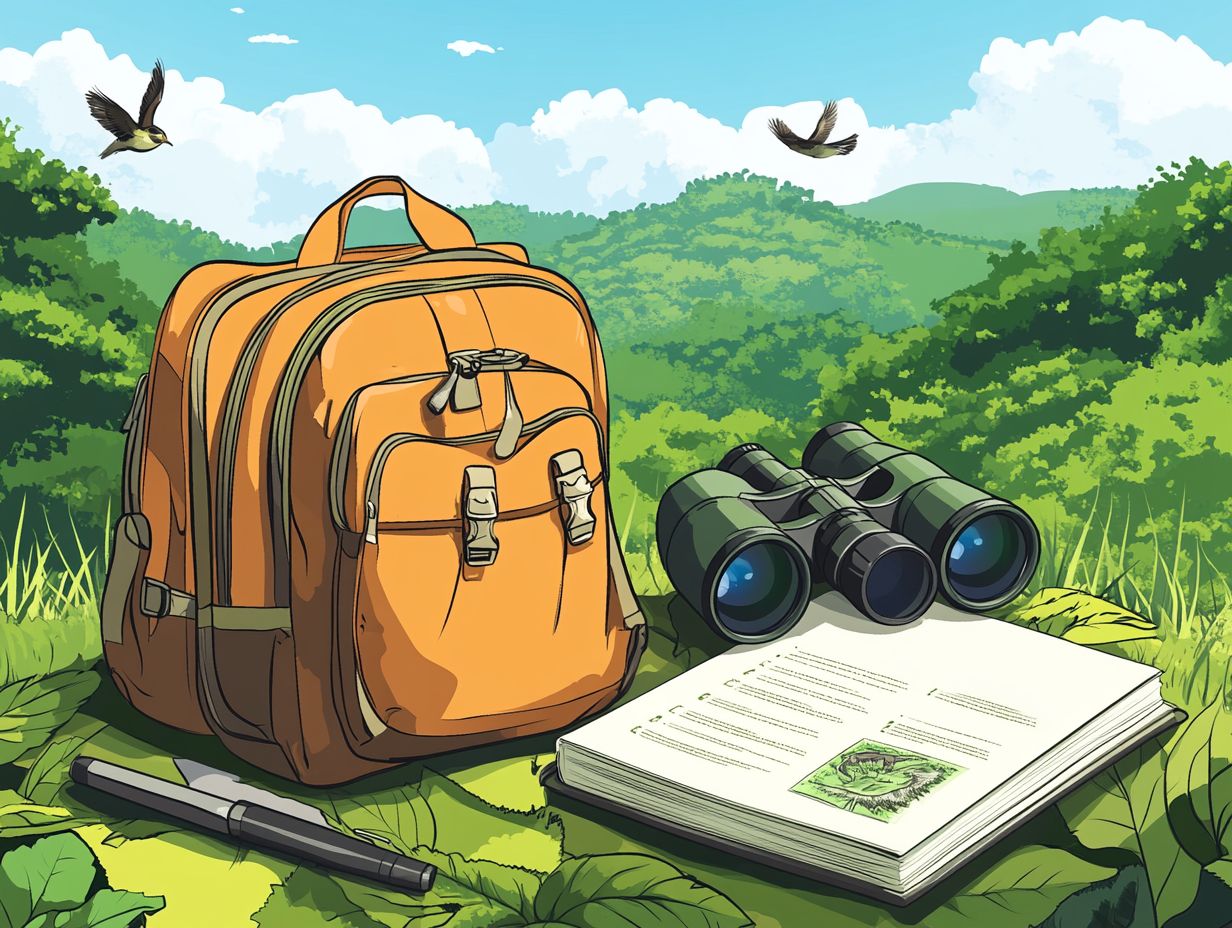
Everglades Safari Park offers you an extraordinary bird watching experience, set against the breathtaking backdrop of one of the most unique ecosystems in the world. Here, you can spot a myriad of bird species and document your adventures with top-notch gear like Nikon or Vortex binoculars and Canon EOS cameras.
With its expansive wetlands and subtropical climate, the park serves as a sanctuary for migratory wading birds, raptors, and many other fascinating species. You’ll be captivated by vibrant roseate spoonbills, graceful wood storks, and striking kingfishers flourishing in this rich environment.
If you’re eager to document your findings, a Canon EOS R5 provides exceptional sharpness and color fidelity. Meanwhile, a Nikon Z7 II excels in low-light conditions, ensuring that those picturesque moments are beautifully captured, whether at dawn or dusk.
Rouge National Urban Park, Woodland Day Use Area
Rouge National Urban Park’s Woodland Day Use Area is your perfect destination for bird watching in an urban oasis. Here, you’ll find a rich tapestry of flora and fauna, complemented by the convenience of AllTrails Pro to guide your exploration of its expansive trails.
This hidden gem grants you easy access to nature and serves as a sanctuary for a myriad of bird species. Picture yourself observing the vibrant American goldfinch and the striking red-tailed hawk, where each visit promises a unique thrill.
The park’s varied habitats attract a diverse avian population, offering outstanding opportunities for both photography and observation. To truly elevate your bird watching adventure, utilizing AllTrails Pro can be a game changer, allowing you to navigate to the best viewpoints with ease. Additionally, knowing how to choose accessories for bird watching can enhance your experience further.
Point Pelee National Park
Point Pelee National Park is celebrated for its outstanding birding opportunities, especially during migration seasons. As a birdwatcher, you can elevate your experience by using tools like eBird and Merlin to track sightings and identify species in this rich environment filled with many kinds of plants and animals.
Recognized as one of North America’s prime migration hotspots, this remarkable park acts as a vital stopover for numerous bird species, allowing them to rest and refuel on their long journeys. Get ready to be amazed by a stunning array of feathered friends, including the vibrant Prothonotary Warbler and the striking Indigo Bunting.
The park’s diverse ecosystems comprising wetlands, forests, and coastal areas create perfect environments for these migratory species. You can also contribute to significant citizen science efforts by engaging with platforms like eBird and Merlin, making each visit all the more gratifying.
Mississippi National River & Recreation Area
The Mississippi National River & Recreation Area is a true sanctuary for birding enthusiasts. With its rich tapestry of habitats, it supports an impressive array of avian populations, making it essential for you to have a field guide at hand to identify local birds while embracing the joy of backyard birding.
As you explore the wetlands, forests, and open fields along the river’s banks, you’ll discover an extraordinary variety of environments where birds thrive. You might catch a glimpse of elegant herons wading through shallow waters or be captivated by the acrobatics of tree swallows darting among the treetops.
You can draw parallels between this vibrant ecosystem and your own backyard, using techniques such as creating inviting feeders and planting native flora to attract local species. By understanding how to replicate these natural habitats, you can elevate your birding experiences and contribute to the vital appreciation of wildlife conservation.
Indiana Dunes National Park
Indiana Dunes National Park invites you to explore a captivating blend of habitats, from sandy beaches to lush wetlands. It s an exceptional destination for birding and birdwatching, allowing you to capture stunning photographs of diverse bird species.
As you wander through this natural paradise, expect to encounter everything from vibrant blue jays and cardinals flitting among the trees to the graceful great blue herons gliding over marshy waters. Each season brings exciting new birds; spring migrations unveil the melodic calls of warblers and various shorebirds as they explore the sandy dunes.
Don’t miss out on visiting prime birdwatching spots like West Beach and the Miller Woods trails, where sightings are frequent and rewarding. For those who love photography, early mornings or late afternoons deliver the best lighting conditions. A zoom lens a lens that allows you to see distant objects clearly can be your best friend, allowing you to capture these beautiful creatures up close without disturbing their natural habitat.
What to Bring for Bird Watching in National Parks
When you’re gearing up for a birdwatching adventure in national parks, pack some essential gear. High-quality binoculars are a must for those close-up views, while a reliable field guide helps identify various species. Don’t forget to include the top 5 essential accessories for bird watching to enhance your experience.
Bring a digital camera to capture incredible moments and create lasting memories, and don’t forget a portable charger to keep your devices powered throughout the day.
Waterproof binoculars can enhance your experience. They offer clarity and durability in unpredictable weather, allowing you to observe wildlife without the fear of damaging your equipment. A comprehensive field guide is also key it helps you identify different bird species and enriches your understanding of their behaviors and habitats.
Having a digital camera on hand allows you to document unique sightings, ensuring you can cherish those memorable moments for years to come. Trust me, a portable charger is invaluable, especially on longer excursions. With it, you can keep your smartphones and cameras operational, allowing you to fully immerse yourself in the joy of birdwatching.
Binoculars
Choosing the right binoculars is essential for your birdwatching adventures. Models like the Nikon Prostaff, Vortex Diamondback, and Swarovski EL provide exceptional clarity and performance, enabling you to enjoy a close-up view of your feathered friends, even in challenging conditions.
Each of these brands has unique strengths catering to different environments. For instance, the Nikon Prostaff is equipped with advanced coatings features that improve visibility that enhance light transmission, making it perfect for early morning or late afternoon excursions when light is scarce.
In contrast, the Vortex Diamondback seamlessly combines durability with performance. Its rugged design can withstand tough weather, making it an ideal companion for your adventurous birdwatching trips in unpredictable climates.
Then there’s the Swarovski EL, celebrated for its superior optics and ergonomic design, perfect for those who value comfort during extended viewing sessions.
Together, these models serve both casual observers and serious birdwatchers, ensuring you have an enriching experience no matter where your explorations take you.
Field Guide
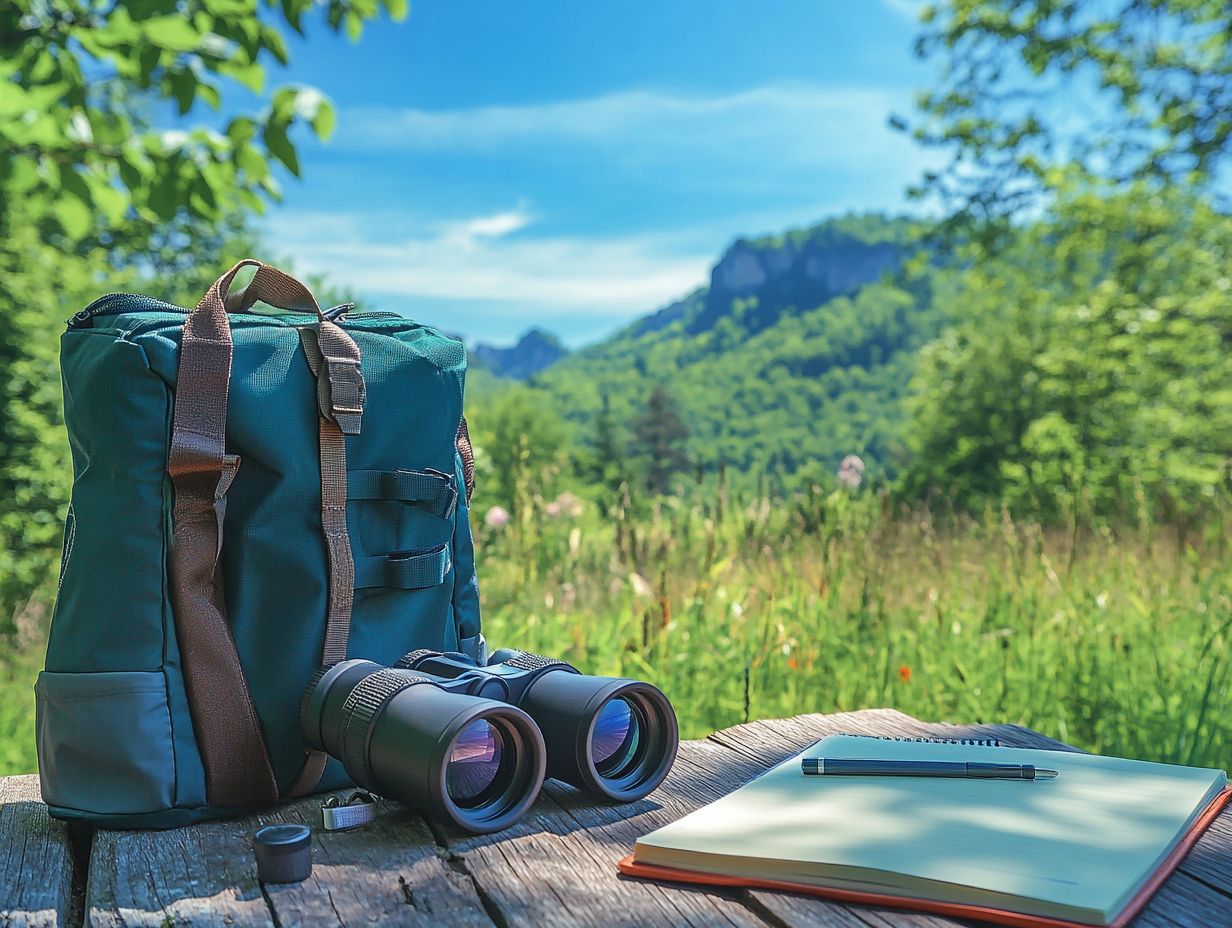
A field guide is an invaluable resource for you as a birdwatcher, aiding in the identification of various species and their habitats. Popular options include the Audubon guide and resources from eBird, which provide up-to-date information on bird sightings.
To truly maximize this tool, familiarize yourself with the layout of the guide before heading out. Take note of distinguishing features described for each species, such as plumage color, size, and unique markings. Listening closely to their vocalizations can also be a game-changer when the birds are tucked away in the foliage.
By combining the field guide with eBird, you not only enhance your experience but also track your sightings in real-time. Plus, sharing your observations contributes to a global database, helping researchers understand avian trends and behaviors.
Camera and Telephoto Lens
A high-quality camera paired with a telephoto lens is essential for capturing breathtaking photographs of birds in their natural habitats. Consider options like the Sony Alpha or Canon EOS, both of which deliver exceptional image quality and versatility tailored for bird photography.
Choosing the right equipment not only enhances your ability to capture intricate details but also elevates your entire experience as you explore diverse environments. Understanding elements such as light conditions and bird behavior can significantly refine your results.
For example, the golden hours of early morning or late afternoon often provide the most flattering light, casting softer shadows and enriching colors. Pairing your digital camera with a fast shutter speed can yield incredible results.
Using settings like a fast shutter speed and higher ISO which helps capture images in low light is crucial for freezing motion and minimizing blur, especially when capturing birds in flight. Don’t hesitate to experiment with various aperture settings, as they can create beautifully blurred backgrounds that draw the viewer’s attention to your subjects.
Comfortable Clothing and Shoes
Wearing comfortable clothing and shoes is crucial for your birding experience, allowing you to move freely and effortlessly through various terrains while immersing yourself in the natural beauty around you.
When you re choosing your birdwatching attire, think about moisture-wicking fabrics that will keep you dry during unexpected rain showers or those sweltering days. A long-sleeved shirt can provide protection against sunburn and pesky insect bites.
Durable trousers with ample pockets are perfect for stashing essentials like binoculars and field guides. Footwear is another key factor; opt for sturdy hiking boots or waterproof shoes to safely navigate muddy paths and rocky areas.
Layering your clothing gives you flexibility to adapt to temperature changes, ensuring that you remain comfortable and ready for anything during your outdoor adventures.
Insect Repellent
Insect repellent is essential for your birdwatching adventures, ensuring a comfortable experience as you immerse yourself in the beauty of the great outdoors, free from the distractions of pesky bugs.
As many devoted birders know, mosquitoes and ticks can quickly turn a serene day in nature into an uncomfortable ordeal. By applying a quality insect repellent, you re not just keeping these nuisances at bay; you’re allowing yourself to stay engaged with your surroundings, fully absorbed in the wonders of the avian world.
Opt for products that contain DEET or picaridin, common ingredients in insect repellents that effectively keep bugs away. Brands like Sawyer and Repel are known for their reliable formulations and are favorites among outdoor enthusiasts.
Selecting a repellent that strikes the right balance between lasting power and a non-greasy feel can significantly elevate your birdwatching experience. Don t wait to apply insect repellent before heading out!
Sunscreen
Applying sunscreen is essential for you as a birdwatcher spending extended periods outdoors, offering crucial protection against harmful UV rays while you revel in the sunlit beauty of nature.
Safeguarding your skin is especially important during those long hours under the sun, particularly since many enthusiasts may not realize how quickly UV exposure can lead to damage. For your captivating outdoor adventures, opting for broad-spectrum sunscreens with an SPF of at least 30 can significantly lower the risk of sunburn.
Spray or lotion options work well because they are easy to apply and quick to absorb. Choosing water-resistant formulas is wise too, ensuring you remain protected even during unexpected moments of sweat or light rain.
Are you ready to explore the great outdoors without pesky bugs bothering you? Get prepared for your next birdwatching adventure today!
Water and Snacks
Staying hydrated and energized is essential for your birdwatching adventures, so be sure to pack ample water and snacks for those long outings in nature where the thrill of bird sightings awaits you.
Without proper hydration, fatigue can creep in before you know it, dulling your experience and alertness the very traits you need to track those elusive species. When you re heading into remote areas, lightweight, long-lasting snacks like mixed nuts, granola bars, and dried fruit can serve as quick energy boosters. Even simple choices like sliced apples or carrots in resealable bags are easy to carry and provide a refreshing crunch.
Preparing snacks ahead of time helps maintain your energy levels, making for a more enjoyable and productive day as you immerse yourself in the captivating avian world around you.
Birding Checklist
Creating a birding checklist is an invaluable tool for you, the avid birdwatcher. It enables you to track the species you’ve encountered and plan future excursions while elevating your overall birding experience.
This simple yet effective practice not only provides a satisfying sense of accomplishment as you observe a diverse array of birds, but it also cultivates a deeper connection with nature. To craft your checklist, consider designating a notebook or utilizing a mobile app specifically tailored for birdwatching.
Be sure to include essential information, such as:
- The bird’s species name
- Date of sighting
- Location
- Weather conditions
- Any notable behaviors
By documenting these details, you ll be able to recall your experiences with clarity and share insights with fellow enthusiasts, enriching your adventures in the field even further.
Birding Apps
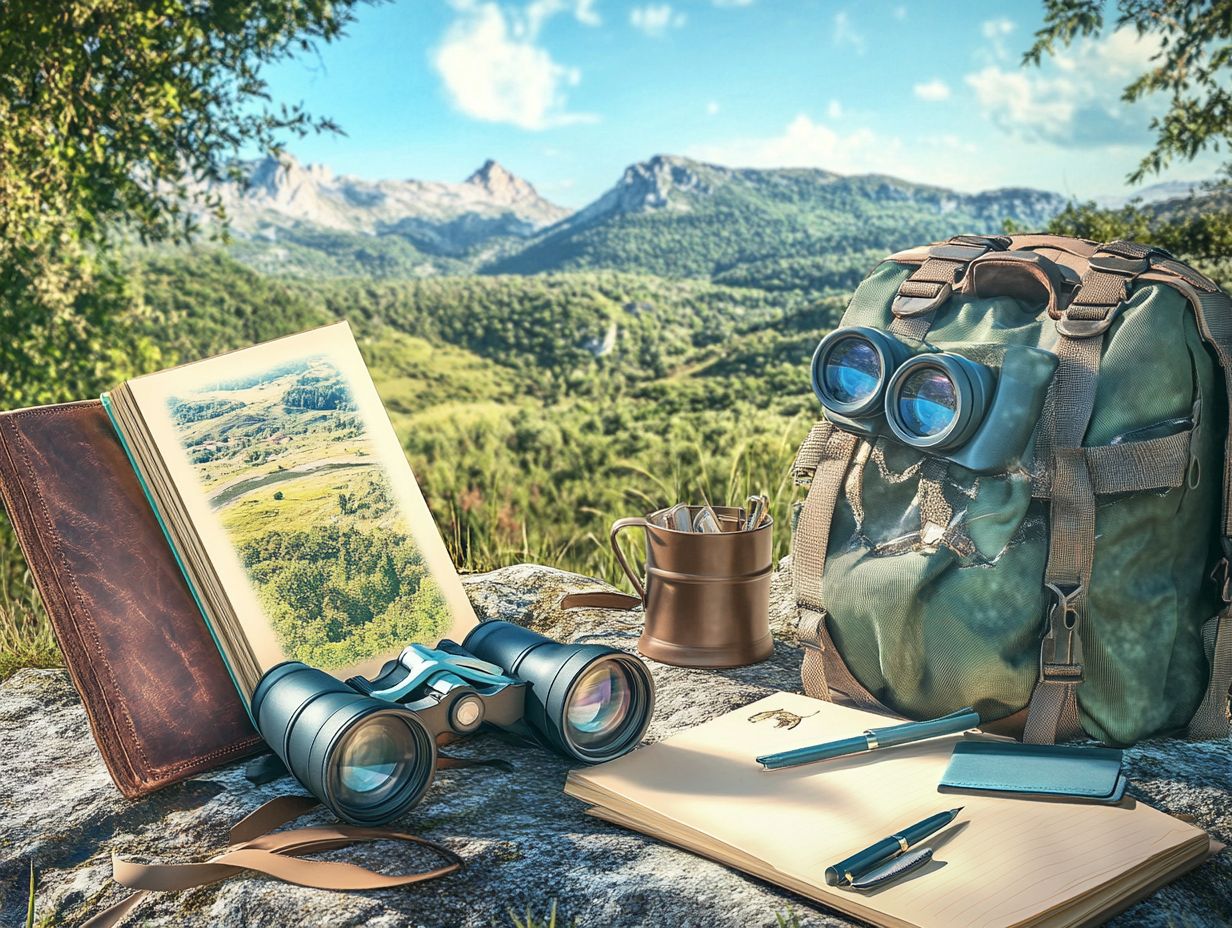
Utilizing birding apps like eBird and Merlin can significantly elevate your birdwatching experience. These amazing tools give you real-time data on bird sightings, easy-to-use identification features, and opportunities for community engagement.
With detailed birding maps at your fingertips, you can effortlessly pinpoint the best locations for spotting specific species. Logging your observations becomes a breeze, allowing you to share your experiences with a vibrant community of fellow birdwatchers, fostering collaboration and the exchange of knowledge.
The apps identification capabilities enable you to match photos and sounds, simplifying the process of distinguishing between similar species. If you re planning birdwatching trips, these tools not only assist in setting your itineraries but also highlight seasonal trends and the routes birds take during migration, ensuring that every expedition is optimized for successful sightings.
Frequently Asked Questions
What are the best accessories for bird watching in national parks?
The best accessories for bird watching in national parks include binoculars, a field guide, a camera, a birding journal, a comfortable backpack, and a water bottle.
Which national parks are the best for bird watching?
Some of the best national parks for bird watching include Bosque del Apache National Wildlife Refuge, Great Dismal Swamp National Wildlife Refuge, Henderson Bird Viewing Preserve, Bombay Hook National Wildlife Refuge, and Madera Canyon. To enhance your experience, consider using the top functional accessories for birders.
What is the importance of a field guide for bird watching in national parks?
A field guide is an essential accessory for bird watching in national parks as it helps to identify different bird species. Additionally, having must-have accessories for serious bird watchers can enhance the experience by providing valuable information about their behavior and habitats.
Why is it important to have a birding journal while bird watching in national parks?
A birding journal allows you to record and track the bird species you have seen, their behavior, and other observations. It can also serve as a great souvenir and reference for future bird watching trips.
What type of camera is best for bird watching in national parks?
A camera with a long zoom lens and fast shutter speed is ideal for capturing clear and detailed photos of birds in their natural habitat. For those interested in this hobby, exploring essential photography accessories for birdwatching can enhance your experience. A DSLR or mirrorless camera would be a great choice for bird watching in national parks.
Start planning your birding adventure today! Share your experiences and tips with fellow birdwatchers to create a sense of community.
Are there any national parks outside of the US that are good for bird watching?
Yes, there are many national parks outside of the US that are perfect for spotting incredible birds!
Some popular options include Rouge National Urban Park in Canada, Point Pelee National Park in Canada, and Everglades Safari Park in Florida.

